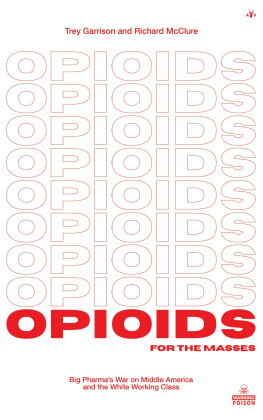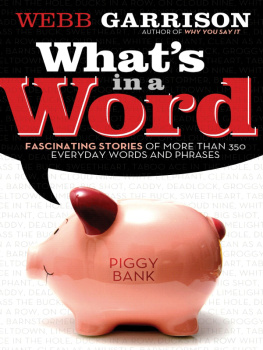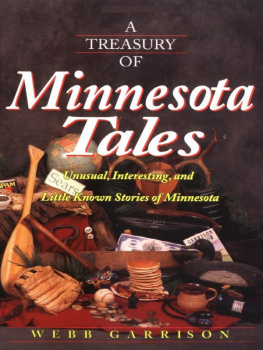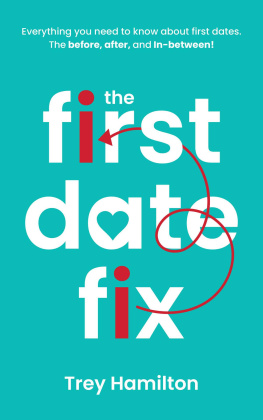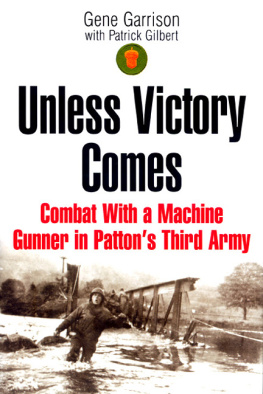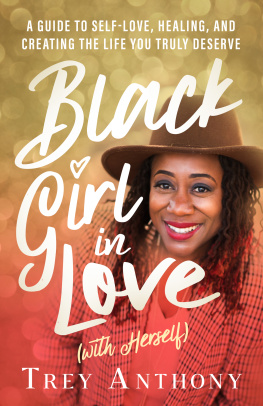Opioids for the Masses:
Big Pharmas War on Middle America
And the White Working Class
OPIOIDS
FOR THE MASSES
Big Pharmas War on Middle America
And the White Working Class
Trey Garrison
&
Richard McClure

A N T E L O P E H I L L P U B L I S H I N G
Copyright 2021 Trey Garrison and Richard McClure
First printing 2021.
All rights reserved. Note that for personal stories, names have been changed.
Cover art by sswifty.
Edited by Taylor Young and Margaret Bauer.
Interior formatting by Margaret Bauer.
The authors can be contacted at:
treygarrison@protonmail.com
Antelope Hill Publishing
www.antelopehillpublishing.com
Paperback ISBN-13: 978-1-953730-89-3
Hardcover ISBN-13: 978-1-953730-91-6
EPUB ISBN-13: 978-1-953730-90-9
For we must all appear before the judgment seat of Christ, so that each of us may receive what is due us for the things done while in the body, whether good or bad.
2 Corinthians 5:10
Contents
1
Lost in America
In the rolling hills and hard mountains of Appalachia it feels like even on the best days you only get sunlight overhead for six hours. These mountains arent high, but the valleys run deep, and the hollows where the locals live are close and intimate. The sun has long retreated behind the western ridge and a cool dampness has settled in this valley. Weve turned off a state highway onto what the navigation says is a county road. Its one lane and has more gravel than concrete. The car is on about a 20-degree grade winding downward into the darkness. This road feels more like a driveway, and in a way, it is.
Were in Eastern Kentucky, trying to find the home of a former OxyContin dealer. If we pull up to the wrong home or farm, or even the right one, we might get greeted by suspicious eyes and a loaded shotgun. We check the navigation again and were definitely lost. And in that way, we arent so different from the America weve come looking for.
The story weve come for began just two decades ago, when a new generation of safer opium-based painkillers triggered an onslaught of prescriptions in America. Tragically and inevitably, these prescriptions were followed by dependence and abuse. In the decades since, opioid overdoses have killed well over 400,000 Americans, closing in on half a million. The wave of prescription drug abuse led to a wave of heroin addiction. What started as legal opiate use has become a crisis of illicit drug abuse. Now, more than half of opioid deaths are caused by synthetic drugs like fentanyl, a chemical thousands of times stronger than heroin and powerful enough to kill in tiny concentrations. Beyond the death toll, at least two million Americans have become addicted. More Americans have died from opiates since the 1990s than died in the entirety of World War II. And more than three times as many Americans have been injured from opiates as soldiers were wounded during that same conflict.
Opiate addiction and death have become a depressing reality for working Americans and their families. Today, 54 percent of Americans know someone who died from a drug overdose. One in three will have a friend who dies from a drug overdose in their lifetime. And drug overdose is now the leading cause of death for Americans under fifty.
Thats what brought us to this quiet valley on a weekday evening in rural Kentucky. Were searching for answers about whats happening and why. Who are the people most affected? When and why did they become addicted? Could it have been prevented? And now that its happened, how can it be stopped? Were convinced theres a deeper story here. And were venturing down into the woods to get our start finding it.
* * *
Theres an old, usually misattributed, quote that holds, one death is a tragedy, but a million is just a statistic. Apocryphal or not, theres truth to the idea. In the modern world, were awash in a blizzard of numbers and data so often that its easy to get lost in the snowstorm. Its easy to forget that there are thousands of personal stories of tragedy and loss hidden inside every such statistic. Then again, every once in a while, you come across a number that crystallizes reality and it can stop you cold.
For us it was this: According to data from the Center for Disease Control and Prevention, overdoses involving opioids killed more than 47,000 Americans in 2017. More than a third of those deaths involved legal, prescription opioids. In 2019, there were 81,000 drug overdose deaths, of which the CDC estimates more than 70 percent were opioid related.
The 2017 number was our hook. We started this project in early 2019 and at the time that was the latest data available. It was shocking.
By comparison, the Vietnam War lasted nineteen years and saw 58,000 Americans die, but in 2017, nearly as many Americans perished from opioid overdoses as in twenty years of war in Southeast Asia. If you include all narcotics, there were 70,237 drug overdose deaths in the United States in 2017, making that year deadlier for Americans than the Vietnam War, Gulf War, Iraq War, and the Afghanistan campaign combined.
And this crisis shows little signs of slowing.
Make no mistake, the bulk of these deaths comes from prescription drugs and synthetic opioids, like OxyContin, Percocet, and others, including the synthetic prescription drug fentanyl. Only half again as many Americans died from truly illegal narcotics like heroin.
The number of legal, prescribed opioids has declined since its peak in 2013, but the astronomical growth prior to that year makes recent declines seem insignificant. When people dependent on prescription opioids cant get legal prescriptions, they increasingly turn to more dangerous alternatives like black market fentanyl and heroin. This is why the number of overdose deaths have tragically continued to climb despite prescriptions declining.
Alcohol and drug abuse have long been a part of the human condition, but the pills that caused this crisis were flooded into parts of the countryrural, working-class communitieswhere drug use was largely frowned upon and marginalized. These pills were doctor recommended and the prescriptions they required brought an air of legitimacy to the use of opioids. Average Americans became addicted without knowing there was any risk. But opiates brought the same dependency and addiction that has always followed the large-scale use of opium derivatives.
Economic setbacks, depression, pain and struggle have always been part of the American story. Our communities have faced ruthless business interests, crime, poverty, economic decline, discrimination, and natural disaster. With limited exceptions, few of these appear to have been as destructive to the social fabric and to the hope we feel for the future. Despair is now simply a part of life in many of the areas of America hardest hit by the opioid epidemic today, whether youre talking about the hollows of Appalachia or small towns in the Rust Belt and the South.
* * *
Opium and its derivatives have been in America since at least the Gold Rush, when Chinese laborers brought the habit with them. Morphine, which is derived from opium but is ten times stronger, was widely used as a painkiller in the Civil War, and historians estimate that about 400,000 American soldiers on both sides became addicted by the wars end.
In the 1870s scientists tried to develop a less addictive form of morphine, and the result, ironically, was heroin. A cautionary tale, if ever there was one. Initial claims by nineteenth century physicians and drug companies led many to believe that heroin was a safe version of morphine. Strikingly similar claims would be made more than a century later, and our collective failure to learn the lessons of the past plays a large role in this narrative.
Next page
